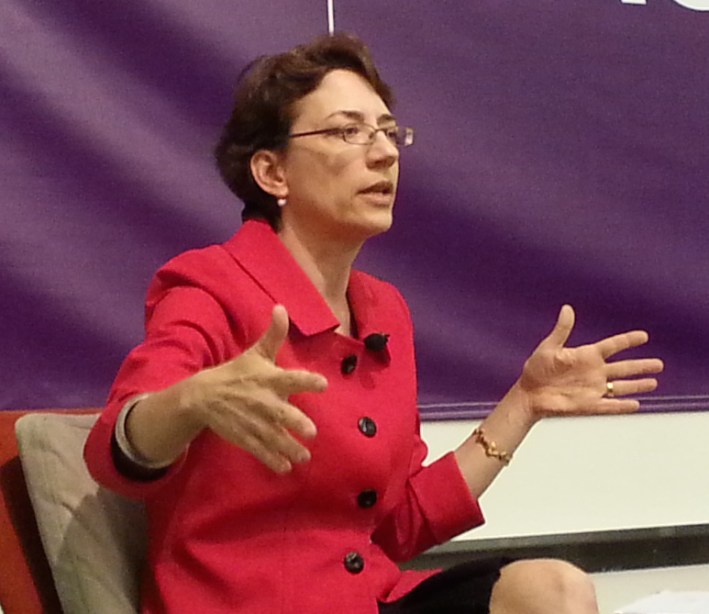Transportation Commissioner Polly Trottenberg sat down for a Q&A with the New York Cycle Club Monday night to lay out her approach to expanding the city's bike network. With NYU Rudin Center director Mitchell Moss moderating, Trottenberg said DOT will keep adding bike lanes on her watch, including protected lanes, without seeking to change a review process that has often delayed or watered down street redesigns despite ample evidence of public support.

“There has been, and I’ll credit my predecessor for this, a sea change in the attitude about bike lanes in New York,” Trottenberg said, referring to former commish Janette Sadik-Khan. While the city's media and political establishment may no longer be in full-blown bikelash mode, Trottenberg noted that not everyone welcomes each new bike project. “At the granular, neighborhood level, you’ll meet folks who don’t like it," she said.
She also defended DOT's deference to community board votes as the agency's default approach to public involvement in bike projects. "The philosophy of working with neighborhoods is a sound one," Trottenberg said. She pointed to West End Avenue, where a recent road diet project added breathing room for cyclists but omitted bike lanes. Bike lanes can easily be added once more cyclists take to the route and the community acclimates to the calmer street, she said. That may be true of painted lanes, but protected lanes would probably involve more intensive upgrades.
Trottenberg has said DOT will add 30 miles of on-street bike lanes each year, including five miles of protected bike lanes, with an eye on neighborhoods beyond already well-served parts of Manhattan and Brooklyn. Audience members requested protected bike lanes on the Harlem River bridges, the Grand Concourse, on the MTA-owned Henry Hudson and Verrazano-Narrows Bridges, and Queens Boulevard, where Trottenberg cited left turns as contributing to a recent uptick in crashes.
During the 2013 race for mayor, Bill de Blasio set a goal of having bicycling account for 6 percent of all trips in New York City by 2020. That's an ambitious target, and a notoriously difficult one to measure. Trottenberg said DOT currently estimates bike mode-share at about 1.5 percent of trips citywide, and that the department is developing new methods to get a more precise measurement. "There’s no question, we’re probably going to need to up our ability to count [cyclists] around the city," she said after the event. "I have to confess, we have not fully figured out how we’re going to do that."
Trottenberg's decision not to take the opportunity to try out completely car-free parks this summer was the subject of one of the event's more pointed questions from the audience. "Instead of happiness, I got nothing but unhappy blowback about how wimpy I was being," she said. Trottenberg cited political support and traffic challenges as obstacles to making Prospect and Central Parks completely car-free. "Before you do something like [car-free parks], you do have to work with the community boards," she said. "Some of the ones around the park are more enthusiastic about car-free than others."
Trottenberg said she has discussed Operation Safe Cycle with NYPD, and credited the department with a slow but steady culture change. "I think NYPD heard pretty loud and clear that people were unhappy with how the blitz turned out, the bike blitz," she said. "They admitted... there were certainly some problems with it." Citing Scandinavia as a model, Trottenberg said she would like enforcement targeted on dangerous corridors for at least six months at a time to change the tenor of driver behavior on the street. She also encouraged street safety advocates to talk with local precinct leadership and join precinct community councils. “Just hearing it from their sister agency is one thing,” she said. “You all need to give them feedback too.”
She was less hopeful about DMV's role in bringing dangerous driving under control. “The biggest cause of crashes is speeding. It turns out that it’s very hard to get speeding convictions," she said. When DMV administrative judges adjudicate speed-related charges, she said, they often give a lot of deference to speeding drivers. "Part of why NYPD doesn’t like to bring those charges is because DMV doesn’t like to convict. And [officers are] held accountable for their conviction rates."
Trottenberg said she would like to see more speed cameras on city streets, and noted that fines in New York are low compared to other nations, which can charge hundreds of dollars for speed cam tickets. Even with all the restrictions Albany places on speed cameras, she said the city made good progress in Albany this year in securing more speed cameras and a lower speed limit. "I was a pessimist," she said of the speed limit bill's chances in Albany. She credited Families For Safe Streets and Transportation Alternatives, whom she called "a remarkably powerful political force." After final action by the City Council, the 25 mph limit will go into effect November 7, Trottenberg said.
DOT is preparing to publish updated benchmarks for implementing its bicycling and Select Bus Service goals, Trottenberg said last night. She also reiterated that news on a deal for Citi Bike, which she said is in the hands of bike-share operator Alta and likely investor REQX Ventures, should be coming soon. “I say this every time, but I really mean it," she said.





